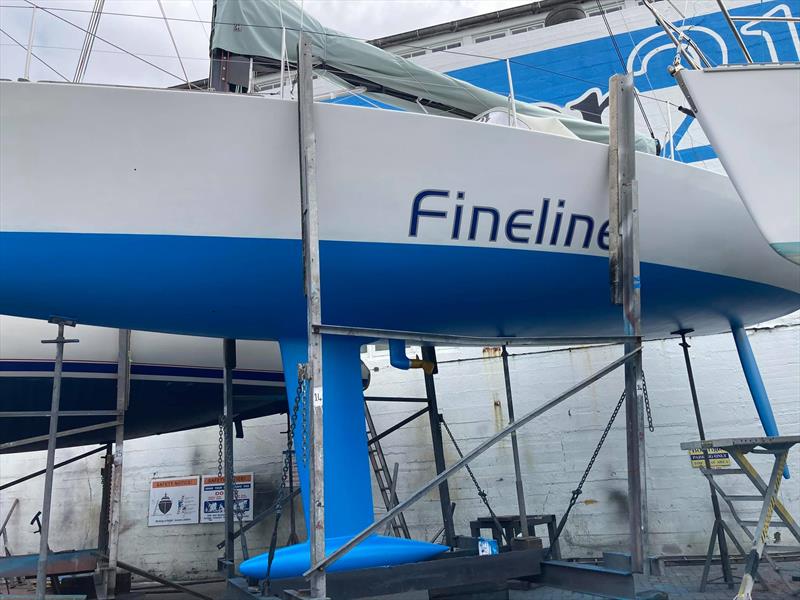
Marine Biosecurity: Antifouling coatings - the line of first defence - Part 1
by Clean Below? Good to Go 13 Oct 2021 13:06 NZDT
13 October 2021

A clean, freshly antifouled hull is key to optimal performance and to avoid carrying marine pests © Marinepests.nz
Part 1 in a series of three articles about antifoul coatings from the team behind ‘Clean Below? Good to go’ addresses how the global industry is coming up with solutions to biofouling challenges.
Antifouling coatings are still our best weapon against marine pests. But many of the traditional formulas come with unwanted side effects for our environment and health and that leaves boat owners concerned about how they can safely – and cost effectively – keep their boat protected from fouling. It’s not a challenge we face alone in New Zealand. We talk to three industry experts about how the antifoul industry is working to find solutions.
Kevin Purdy is an independent consultant to the industry who has specialised in making antifouling coatings for 40 years. He firmly believes the global industry will come up with solutions to the challenges it faces.
“All manufacturers of antifouling coatings are putting their best foot forward to create effective biocides that comply with the regulations and that is the best we can possibly do.”
He says this is far from a New Zealand problem – it is a global challenge to find good antifouling coatings that are mechanically sound (meaning that they don’t peel or flake) and which are also environmentally compatible and do the job they were designed for.
Like most in the industry he understands the need for biosecurity measures to minimise the harm that marine pests can potentially do and is concerned about anecdotal reports of some barnacles becoming more tolerant to copper, as is happening in parts of Northland. However, he is confident of the industry’s ability to present solutions given time.
One of the challenges locally, says Kevin is that our market is fairly small and manufacturers cannot necessarily sustain the costs of registration via the Environmental Protection Authority of their products in New Zealand.
“Any change to a formulation is a multi-year programme for us. It takes at least five years from panel testing to getting it on boats,” he explains.
One of New Zealand’s biggest producers of antifouling coatings is getting ready to bring a new product to market.
Neil Debenham is Regulatory Affairs Manager from Altex Coatings. He has been in the position since well before the Environmental Protection Authority reviewed antifoul paints in 2013 and he is part of the team working on new products that can be used when the biocides currently in existence are ruled out of use in 2023.
“In 2023 we will take five brands off the market and replace them with an altogether new product,” says Neil.
The new product – under wraps for commercial reasons – will have performance improvements in some areas, but may compromise in others, he explains. At the moment Altex is ensuring the product meets all of the necessary legal requirements so that it can prepare to go to market.
AkzoNobel Coatings Limited is in sixty countries around the world. Its most well-known brand of marine paint is International® - a brand available at most chandleries around the country.
Under the company’s policy of international product stewardship, Manager Adrian White says that some products had already been discontinued well before the EPA’s 2013 review and that customers can therefore be confident their favourite International® product will remain available in the future.
“We have adopted more specific biocides that, once released from the coating and have done their job have a shorter ‘half-life’ so break down sooner and therefore have less opportunity to remain in the environment. This was one of the main drivers that lead to ‘tin based’ antifoulings being globally banned over 20 years ago,” he explains.
He says that in Europe and the UK copper is still the biocide of choice – as it often is in New Zealand because it is seen as most effective. Copper, he says, works well against animal growth but you either need a lot of it to prevent plant growth or you need something else and multi-biocide option gives a better performance.
He says that while rules in New Zealand are strict, they are stricter in Australia and that because of their product stewardship approach, their brands also meet Australia’s standards.
The information expressed in this article is the opinion of those interviewed and not necessarily that of ‘Clean Below? Good to Go’. Please seek expert advice when choosing and applying an antifoul coating.
Get more info about marine biosecurity in NZ at marinepests.nz